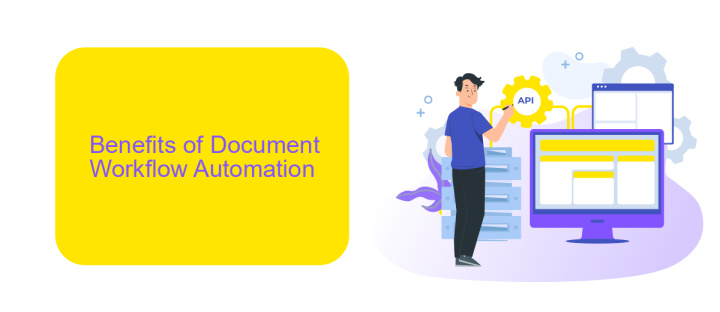Document Workflow Automation
Document Workflow Automation revolutionizes the way businesses handle their paperwork by streamlining processes, reducing errors, and enhancing productivity. By automating repetitive tasks and integrating digital tools, organizations can ensure smoother operations and focus on strategic initiatives. This article explores the key benefits, implementation strategies, and the transformative impact of adopting automated document workflows in today's fast-paced business environment.
Introduction
Document workflow automation is reshaping the way businesses handle their documents, streamlining processes and enhancing efficiency. By automating repetitive tasks, organizations can save time, reduce errors, and focus on more strategic activities. This transformation is crucial in today's fast-paced business environment, where staying competitive requires agility and innovation.
- Improved efficiency through reduced manual intervention
- Enhanced accuracy by minimizing human errors
- Cost savings from reduced labor and operational expenses
- Better compliance and audit trails
- Increased productivity by freeing up valuable resources
Integrating various systems and applications is essential for seamless document workflow automation. Tools like ApiX-Drive facilitate these integrations by connecting different platforms effortlessly, ensuring data flows smoothly across systems. This not only simplifies the automation process but also enhances the overall effectiveness of document management strategies. Embracing such technologies empowers organizations to stay ahead in the competitive landscape.
Benefits of Document Workflow Automation

Document workflow automation significantly enhances productivity by streamlining repetitive tasks, reducing the need for manual intervention. This leads to faster processing times and minimizes the risk of human error, ensuring that documents are processed accurately and efficiently. By automating workflows, organizations can allocate resources more effectively, allowing employees to focus on more strategic and value-added activities.
Additionally, document workflow automation improves compliance and security by maintaining consistent processes and providing audit trails for all document actions. Integration with services like ApiX-Drive further enhances this by enabling seamless connectivity between different software systems, ensuring that data flows smoothly and consistently across platforms. This not only enhances operational efficiency but also supports better decision-making by providing real-time access to accurate information.
Challenges of Document Workflow Automation

Implementing document workflow automation presents several challenges that organizations must navigate to achieve optimal efficiency. One of the primary issues is the integration of various software systems that manage different aspects of document processing. Ensuring seamless communication between these systems can be complex and time-consuming.
- Data Security: Protecting sensitive information during automated processes is crucial. Organizations must ensure that their automation tools comply with data protection regulations.
- System Integration: Integrating disparate systems can be challenging. Tools like ApiX-Drive can simplify this by providing a platform for seamless integration between various applications and services.
- User Adoption: Employees may resist changes to their workflow. Providing adequate training and support is essential to ensure smooth adoption of new automated processes.
- Scalability: As organizations grow, their document workflow automation systems must scale accordingly. This requires careful planning and investment in scalable solutions.
Despite these challenges, the benefits of document workflow automation, such as increased efficiency and reduced errors, make it a worthwhile endeavor. By addressing these obstacles with the right strategies and tools, organizations can successfully implement and benefit from automated workflows.
Best Practices for Implementing Document Workflow Automation

Implementing document workflow automation can significantly enhance efficiency and reduce errors in your organization. To achieve the best results, it's essential to follow some best practices. Start by thoroughly analyzing your current document workflows to identify bottlenecks and inefficiencies. This will help you understand which processes need automation the most.
Next, choose the right tools and technologies that align with your organization's needs. Ensure that the selected automation software is user-friendly and capable of integrating with your existing systems. For instance, using a service like ApiX-Drive can simplify integration by connecting various applications without requiring extensive coding skills.
- Map out your workflow processes clearly before automating them.
- Ensure data security and compliance with relevant regulations.
- Provide adequate training for your team to use the new system effectively.
- Continuously monitor and optimize the automated workflows for improvements.
Finally, maintain open communication with your team throughout the implementation process. Gather feedback and make necessary adjustments to ensure the automation solution meets everyone's needs. By adhering to these best practices, you can successfully implement document workflow automation and achieve greater operational efficiency.
Conclusion
Document workflow automation is a transformative approach that enhances operational efficiency by streamlining and automating document-related processes. By reducing manual intervention, organizations can minimize errors, accelerate turnaround times, and ensure compliance with regulatory standards. The integration of advanced technologies such as artificial intelligence and machine learning further optimizes these workflows, providing intelligent insights and predictive analytics that drive informed decision-making.
Moreover, the adoption of automation tools like ApiX-Drive facilitates seamless integration between various applications and services, ensuring a cohesive and unified workflow. This not only simplifies the process of managing documents across different platforms but also enhances collaboration and communication within teams. As businesses continue to evolve in the digital age, embracing document workflow automation will be crucial in maintaining competitiveness, improving productivity, and achieving long-term success.


FAQ
What is Document Workflow Automation?
How can Document Workflow Automation benefit my business?
Is it difficult to implement Document Workflow Automation?
What types of documents can be automated?
How can I integrate different systems for seamless Document Workflow Automation?
Time is the most valuable resource in today's business realities. By eliminating the routine from work processes, you will get more opportunities to implement the most daring plans and ideas. Choose – you can continue to waste time, money and nerves on inefficient solutions, or you can use ApiX-Drive, automating work processes and achieving results with minimal investment of money, effort and human resources.

